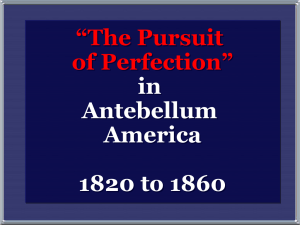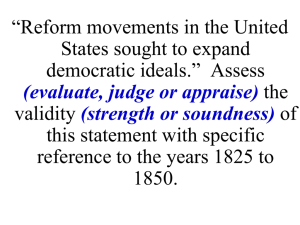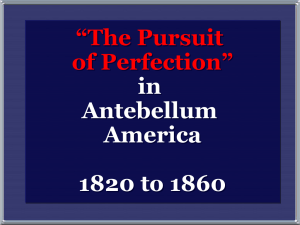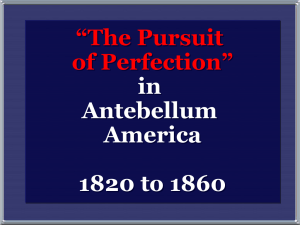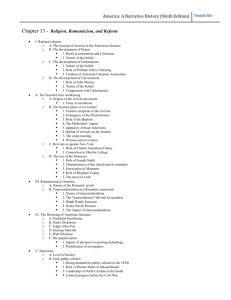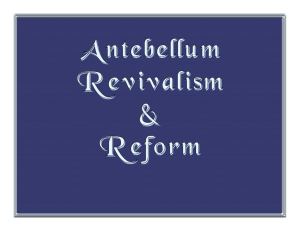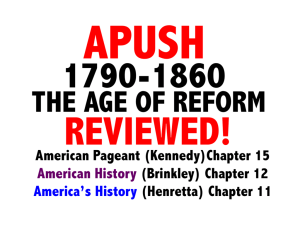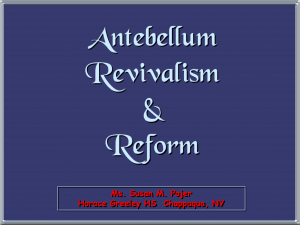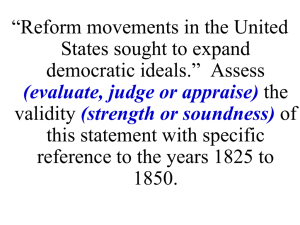The Second Great Awakening
advertisement
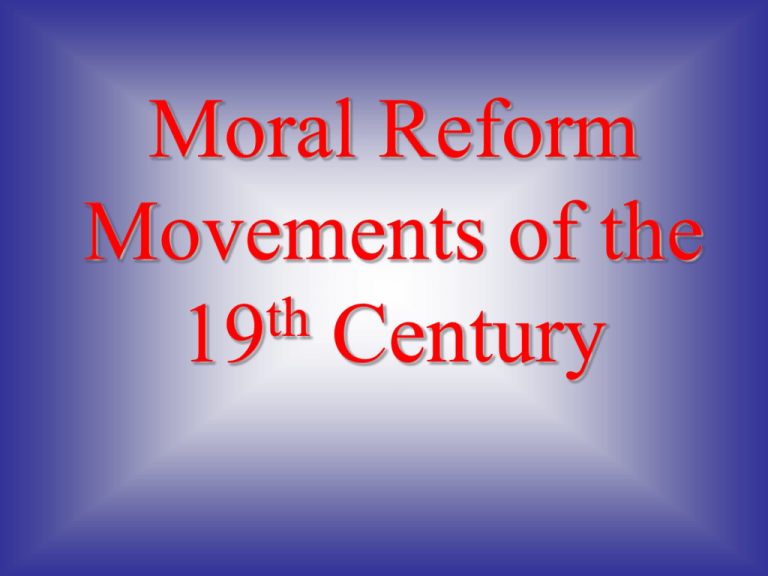
Moral Reform Movements of the th 19 Century 1. Govt. gets its authority from the citizens. 2. A selfless, educated citizenry. 3. Elections should be frequent. The “Virtuous Republic” or moral excellence 4. Govt. should guarantee individual rights & freedoms. 5. Govt.’s power should be limited [checks & balances]. 6. The need for a written Constitution. 7. “E Pluribus Unum.” [“Out of many, one”] Roman statesman regarded as a model of simple virtue; he twice was called to assume dictatorship of Rome and each time retired to his farm (519-438 BC) 8. An important role for women raise good, virtuous citizens. [“Republican Womanhood”]. “The Pursuit of Perfection” In Antebellum America 1820 to 1860 The Second Great Awakening “Spiritual Reform From Within” [Religious Revivalism] Social Reforms & Redefining the Ideal of Equality Temperance Education Abolitionism Asylum & Penal Reform Women’s Rights The Rise of Popular Religion In France, I had almost always seen the spirit of religion and the spirit of freedom pursuing courses diametrically opposed to each other; but in America, I found that they were intimately united, and that they reigned in common over the same country… Religion was the foremost of the political institutions of the United States. -- Alexis de Tocqueville, 1832 •Reformers sought to purify the nation by removing sins of slavery, intemperance (alcohol), male domination and war….. •Some removed themselves from society and tried to create Utopian societies based on collective ownership (socialism/communism) •Reformers used education, lyceum meetings, newspapers in inform public of their issues….. •Reformers questioned the value of material progress in an age of industrialization if it were not accompanied by progress in solving the important human problems •Primarily a Northern movement •Southerners resisted reform movements because it feared abolition of slavery Purifying the Nation •Unitarians believed one could show the love of God by helping others…. •Developed a “social conscience” for improving the quality of life in society •Age of Reform 1820 to 1860 •Ante-Belleum or before the Civil War •Romantic Age •2nd Great Awakening •Reformers pointed out the inequality in society stating the DOI as the basis of their argument… •Rise of Unitarians who believed a God of love instead of the Puritan concept of an angry God. The Second Great Awakening Second Great Awakening • As a result of the Second Great Awakening (a series of revivals in the 1790s-early 1800s), the dominant form of Christianity in America became evangelical Protestantism – Membership in the major Protestant churches— Congregational, Presbyterian, Baptist, and Methodist—soared – By 1840 an estimated half of the adult population was connected to some church, with the Methodists emerging as the largest denomination in both the North and the South Revivalism and the Social Order • Society during the Jacksonian era was undergoing deep and rapid change – The revolution in markets brought both economic expansion and periodic depressions. • To combat this uncertainty reformers sought stability and order in religion – Religion provided a means of social control in a disordered society – Churchgoers embraced the values of hard work, punctuality, and sobriety – Revivals brought unity and strength and a sense of peace 1816 -> American Bible Society Founded Charles Finney • Charles Finney conducted his own revivals in the mid 1820s and early 1830s • He rejected the Calvinist doctrine of predestination – adopted ideas of free will and salvation to all • Really popularized the new form of revival Charles Finney and the Conversion Experience • New form of revival – Meeting night after night to build excitement – Speaking bluntly – Praying for sinners by name – Encouraging women to testify in public – Placing those struggling with conversion on the “anxious bench” at the front of the church Charles G. Finney (1792 – 1895) “soul-shaking” conversion R1-2 The ranges of tents, the fires, reflecting light…; the candles and lamps illuminating the encampment; hundreds moving to and fro…;the preaching, praying, singing, and shouting,… like the sound of many waters, was enough to swallow up all the powers of contemplation. Burned Over District • Burned over district in Western NY got its name from a “wild fire of new religions” The “Burned-Over” District in Upstate New York The Rise of African American Churches • Revivalism also spread to the African American community • The Second Great Awakening has been called the "central and defining event in the development of Afro-Christianity“ • During these revivals Baptists and Methodists converted large numbers of blacks The Rise of African American Churches • This led to the formation of all-black Methodist and Baptist churches, primarily in the North • African Methodist Episcopal (A. M. E.) had over 17,000 members by 1846 Other Churches Founded • While the Protestant revivals sought to reform individual sinners, others sought to remake society at large • Mormons – The Church of Jesus Christ of Latter-Day Saints • Founded by Joseph Smith in western NY •In 1827, Smith announced that he had discovered a set of golden tablets on which was written the Book of Mormon •Proclaiming that he had a commission from God to reestablish the true church, Smith gathered a group of devoted followers Mormons • Mormon culture upheld the middle-class values of hard work, self-control, and • He tried to create a City of Zion: Kirkland, Ohio, Independence, Missouri, then to Nauvoo, Illinois. • His unorthodox teachings led to persecution and mob violence. • Smith was murdered in 1844 by an antiMormon mob in Carthage, Illinois. • Church in conflict Violence against Mormons Mormons • Brigham Young, Smith’s successor, led the Mormons westward in 1846-1847 to Utah where they could live and worship without interference Transcendentalism “Liberation from understanding and the cultivation of reasoning.” “Transcend” the limits of intellect and allow the emotions, the SOUL, to create an original relationship with the Universe. Transcendentalist Intellectuals/Writers Concord, MA Ralph Waldo Emerson Nature (1832) Self-Reliance (1841) “The American Scholar” (1837) Henry David Thoreau Walden (1854) Resistance to Civil Disobedience (1849) The Transcendentalist Agenda Give freedom to the slave. Give well-being to the poor and the miserable. Give learning to the ignorant. Give health to the sick. Give peace and justice to society. Other Important Authors • • • • • • • • Herman Melville – Moby Dick, Bartleby the Scrivner John Greenleaf Whittier – puritan poet Oliver W. Holmes, Sr. James Russell Lowell Emily Dickinson – “The Fly Buzzed Before I Died” Bronson and Louisa M. Alcott “Little Men and Women” Edgar Allen Poe “The Raven”, The Tell-Tale Heart” Walt Whitman “Leaves of Grass” A Transcendentalist Critic: Nathaniel Hawthorne (1804-1864) Their pursuit of the ideal led to a distorted view of human nature and possibilities: * The Blithedale Romance One should accept the world as an imperfect place: * Scarlet Letter * House of the Seven Gables • "For of all sad words of tongue or pen, The saddest are these: 'It might have been!'" from Whittier's "Maud Miller" Satirists, Popular during the Civil War The Art during the Antebellum Period Art during the Antebellum Period • Hudson River School – Thomas Cole, Frederic Edwin Church, Albert Bierstadt • Not just topographic but the art is interpretive, poetic views of nature • Formal composition of the art with attention to detail • harmony in nature • Symbol of the Hudson River School, broken tree stump American Art, 1820-60 continued.. • Nature on a grand scale with smaller figures of man and markers of civilization • Use of panoramas to show immensity of nature and insignificance of human beings • Distant or elevated perspective • Symbolic use of light and darkness • Contrast of diverse elements to show the unity of nature • Morning, Looking East Over the Hudson Valley from the Catskill Mountains – Church • Lake Winnepesaukee, Thomas Cole Niagara Frederic Church, 1857 View of the Catskills, Early Autumn Thomas Cole, 1837 Kindred Spirits – Asher Durand, 1849 Patriotic Art The Landing of the Pilgrims Unknown Artist, 1830s Washington Crossing the Delaware Emmanuel Gottlieb Leutze, 1851 George Washington Horatio Greenough, 1841 The “New Cincinnatus”? Education Reform Educational Reform In 1800 Massachusetts was the only state requiring free public schools supported by community funds Middle-class reformers called for tax-supported education, arguing to business leaders that the new economic order needed educated workers Educational Reform Under Horace Mann’s leadership in the 1830s, Massachusetts created a state board of education and adopted a minimumlength school year. Provided for training of teachers, and expanded the curriculum to include subjects such as history and geography The McGuffey Eclectic Readers Used religious parables to teach “American values.” Teach middle class morality and respect for order. Teach “3 Rs” + “Protestant ethic” (frugality, hard work, sobriety) R3-8 Educational Reform By the 1850s the number of schools, attendance figures, and school budgets had all increased sharply School reformers enjoyed their greatest success in the Northeast and the least in the South Southern planters opposed paying taxes to educate poorer white children Educational opportunities for women also expanded In 1833 Oberlin College in Ohio became the first coeducational college. Four years later the first all-female college was founded — Mount Holyoke, Massachusetts Asylum Reform The Asylum Movement (orphanages, jails, hospitals) • Asylums isolated and separated the criminal, the insane, the ill, and the dependent from outside society • “Rehabilitation” – The goal of care in asylums, which had focused on confinement, shifted to the reform of personal character The Asylum Movement • Dorothea Dix, a Boston schoolteacher, took the lead in advocating state supported asylums for the mentally ill • She attracted much attention to the movement by her report detailing the horrors to which the mentally ill were subjected – being chained, kept in cages and closets, and beaten with rods • In response to her efforts, 28 states maintained mental institutions by 1860 Dorothea Dix Asylum 1849 Temperance Movement Temperance Movement 5. Temperance Movement 1826 - American Temperance Society “Demon Rum”! Frances Willard R1-6 The Beecher Family •Lyman Beecher •Neal Dow •Lucretia Mott •Anti-Alcohol movement •American Temperance Society formed at Boston-----1826 • sign pledges, pamphlets, anti-alcohol tract 10 nights in a Barroom and What I Saw There •Demon Drink adopt 2 major line attack •stressed temperance and individual will to resist The Temperance Movement • During the next decade approximately 5000 local temperance societies were founded • As the movement gained momentum, annual per capita consumption of alcohol dropped sharply The Drunkard’s Progress From the first glass to the grave, 1846 Temperance Movement • The most significant reform movements of the period sought not to withdraw from society but to change it directly • Temperance Movement — undertook to eliminate social problems by curbing drinking – Led largely by clergy, the movement at first focused on drunkenness and did not oppose moderate drinking – In 1826 the American Temperance Society was founded, taking voluntary abstinence as its goal. Abolitionism Abolitionist Movement Create a free slave state in Liberia, West Africa. No real anti-slavery sentiment in the North in the 1820s & 1830s. Gradualists Immediatists Abolitionist Movement 1816 --> American Colonization Society created (gradual, voluntary emancipation. British Colonization Society symbol Abolitionism • William Lloyd Garrison, publisher of the The Liberator, first appeared in 1831 and sent shock waves across the entire country – He repudiated gradual emancipation and embraced immediate end to slavery at once – He advocated racial equality and argued that slaveholders should not be compensated for freeing slaves. Other White Abolitionists Lewis Tappan James Birney Liberty Party. Ran for President in 1840 & 1844. Arthur Tappan The Liberator Premiere issue January 1, 1831 Abolitionism • Free blacks, such as Frederick Douglass, who had escaped from slavery in Maryland, also joined the abolitionist movement • To abolitionists, slavery was a moral, not an economic question • But most of all, abolitionists denounced slavery as contrary to Christian teaching • 1845 --> The Narrative of the Life Of Frederick Douglass • 1847 --> “The North Star” Anti-Slavery Alphabet The Tree of Slavery—Loaded with the Sum of All Villanies! Black Abolitionists David Walker (1785-1830) 1829 --> Appeal to the Colored Citizens of the World Fight for freedom rather than wait to be set free by whites. Sojourner Truth (1787-1883) or Isabella Baumfree 1850 --> The Narrative of Sojourner Truth Sojourner Truth: Ain't I A Woman?1851 Women's Convention, Akron, Ohio • Well, children, where there is so much racket there must be something out of kilter. I think that 'twixt the negroes of the South and the women at the North, all talking about rights, the white men will be in a fix pretty soon. But what's all this here talking about? • That man over there says that women need to be helped into carriages, and lifted over ditches, and to have the best place everywhere. Nobody ever helps me into carriages, or over mudpuddles, or gives me any best place! And ain't I a woman? Look at me! Look at my arm! I have ploughed and planted, and gathered into barns, and no man could head me! And ain't I a woman? I could work as much and eat as much as a man - when I could get it - and bear the lash as well! And ain't I a woman? I have borne thirteen children, and seen most all sold off to slavery, and when I cried out with my mother's grief, none but Jesus heard me! And ain't I a woman? • Then they talk about this thing in the head; what's this they call it? [member of audience whispers, "intellect"] That's it, honey. What's that got to do with women's rights or negroes' rights? If my cup won't hold but a pint, and yours holds a quart, wouldn't you be mean not to let me have my little half measure full? • Then that little man in black there, he says women can't have as much rights as men, 'cause Christ wasn't a woman! Where did your Christ come from? Where did your Christ come from? From God and a woman! Man had nothing to do with Him. • If the first woman God ever made was strong enough to turn the world upside down all alone, these women together ought to be able to turn it back , and get it right side up again! And now they is asking to do it, the men better let them. • Obliged to you for hearing me, and now old Sojourner ain't got nothing more to say. The Underground Railroad “Conductor” ==== leader of the escape “Passengers” ==== escaping slaves “Tracks” ==== routes “Trains” ==== farm wagons transporting the escaping slaves “Depots” ==== safe houses to rest/sleep Harriet Tubman (1820-1913) Helped over 300 slaves to freedom. $40,000 bounty on her head. Served as a Union spy during the Civil War. “Moses” The Underground Railroad Leading Escaping Slaves Along the Underground Railroad Growth of slavery Growth of slavery •Gag rule was passed in Congress which nothing concerning slavery could be discussed. •Under the gag rule, anti-slavery petitions were not read on the floor of Congress •The rule was renewed in each Congress between 1837 and 1839. •In 1840 the House passed an even stricter rule, which refused to accept all anti-slavery petition. On December 3, 1844, the gag rule was repealed Abolitionism: Division and Opposition Abolitionism forced the churches to face the question of slavery head-on, and in the 1840s the Methodist and Baptist churches each split into northern and southern organizations over the issue of slavery Even the abolitionists themselves splintered More conservative reformers wanted to work within established institutions, using churches and political action to end slavery Women Rights Early 19c Women 1. Unable to vote. 2. Legal status of a minor. 3. Single --> could own her own property. 4. Married --> no control over her property or her children. 5. Could not initiate divorce. 6. Couldn’t make wills, sign a contract, or bring suit in court without her husband’s permission. “Separate Spheres” Concept Republican Motherhood evolved into the “Cult of Domesticity” A woman’s “sphere” was in the home (it was a refuge from the cruel world outside). Her role was to “civilize” her husband and family. An 1830s MA minister: The power of woman is her dependence. A woman who gives up that dependence on man to become a reformer yields the power God has given her for her protection, and her character becomes unnatural! Cult of Domesticity = Slavery The 2nd Great Awakening inspired women to improve society. Angelina Grimké Sarah Grimké Southern Abolitionists R2-9 Lucy Stone American Women’s Suffrage Assoc. edited Woman’s Journal Seneca Falls Declaration Women & the Economy • 1850: 10% of white women working for pay outside home – Vast majority of working women were single – Left paying jobs upon marriage • “Cult of domesticity” – Cultural idea that glorifies homemaker • Empowers married women – Increased power & independence of women in home led to decline in family size Women Educators Troy, NY Female Seminary curriculum: math, physics, history, geography. train female teachers Emma Willard (1787-1870) 1837 --> she established Mt. Holyoke [So. Hadley, MA] as the first college for women. Mary Lyons (1797-1849) Women’s Rights Movement When abolitionists divided over the issue of female participation, women found it easy to identify with the situation of the slaves 1848: Feminist reform led to Seneca Falls Convention Significance: launched modern women’s rights movement Established the arguments and the program for the women’s rights movement for the remainder of the century What It Would Be Like If Ladies Had Their Own Way! Women’s Rights 1840 --> split in the abolitionist movement over women’s role in it. London --> World Anti-Slavery Convention Lucretia Mott Elizabeth Cady Stanton 1848 --> Seneca Falls Declaration of Sentiments The first Woman’s rights movement was in Seneca Falls, New York in 1849…… •Educational and professional opportunities •Property rights •Legal equality •repeal of laws awarding the father custody of the children in divorce. •Suffrage rights •The following is an excerpt from the Seneca Falls Declaration written by Elizabeth Cady Stanton. •Notice that the language and wording is similar to the Declaration of Independence. We hold these truths to be selfevident that all men and women are created equal; that they are endowed by their Creator with certain inalienable rights; that among these are life, liberty and the pursuit of happiness; that to secure these rights governments are instituted, deriving their just powers from the consent of the governed…… The history of mankind is a history of repeated injuries and usurpations on the part of man toward woman, having in direct object the establishment of an absolute tyranny over her. To prove this, let facts be submitted to a candid world…. •He has made her, if married, in the eye of the law, civilly dead. •He has taken from all right in property, even to the wages she earns. He has made her, morally, an irresponsible being, as she can commit many crimes with impunity, provided they be done in the presence of her husband. In the covenant of marriage, she is compelled to promise obedience to her husband, he becoming, to all intents and purposes, her master; the law giving him power to deprive her of her liberty, and to administer chastisement. Susan B. Anthony on Marriage and Slavery “The married women and their legal status. What is servitude? “The condition of a slave.” What is a slave? “A person who is robbed of the proceeds of his labor; a person who is subject to the will of another…” I submit the deprivation by law of ownership of one’s own person, wages, property, children, the denial of right as an individual, to sue and be sued, to vote, and to testify in the courts, is a condition of servitude most bitter and absolute, though under the sacred name of marriage. Utopian Communities • The Shakers – Ann Lee – 1774 – The Shakers used dancing as a worship practice – Shakers practiced celibacy, separating the sexes as far as practical – Shakers worked hard, lived simply (built furniture), and impressed outsiders with their cleanliness and order – Lacking any natural increase, membership began to decline after 1850, from a peak of about 6000 members Mother Ann Lee (1736-1784) The Shakers If you will take up your crosses against the works of generations, and follow Christ in the regeneration, God will cleanse you from all unrighteousness. Remember the cries of those who are in need and trouble, that when you are in trouble, God may hear your cries. If you improve in one talent, God will give you more. Shaker Meeting Shaker Hymn 'Tis the gift to be simple, 'Tis the gift to be free, 'Tis the gift to come down where you ought to be, And when we find ourselves in the place just right, 'Twill be in the valley of love and delight. When true simplicity is gained To bow and to bend we shan't be ashamed, To turn, turn will be our delight, 'Till by turning, turning we come round right. Shaker Simplicity & Utility Utopian Communities • • • • The Oneida Community Brook Farm New Harmony Transcendentalists Secular Utopian Communities Individual Freedom Demands of Community Life spontaneity discipline self-fulfillment organizational hierarchy The Oneida Community New York, 1848 Millenarianism --> the 2nd coming of Christ had already occurred. Humans were no longer obliged to follow the moral rules of the past. • all residents married John Humphrey Noyes (1811-1886) to each other. • carefully regulated “free love.” George Ripley (1802-1880) Brook Farm West Roxbury, MA Robert Owen (1771-1858) character is formed by the effects of the environment upon the individual. Utopian Socialist “Village of Cooperation” Man, being naturally good, could grow and flourish when evil was removed education was of central importance to the creation of rational and humane character, educator was to provide the natural environment, both mental and physical, in which the child could develop. Physical punishment was prohibited and child labor was restricted. Original Plans for New Harmony, IN New Harmony in 1832 New Harmony, IN
